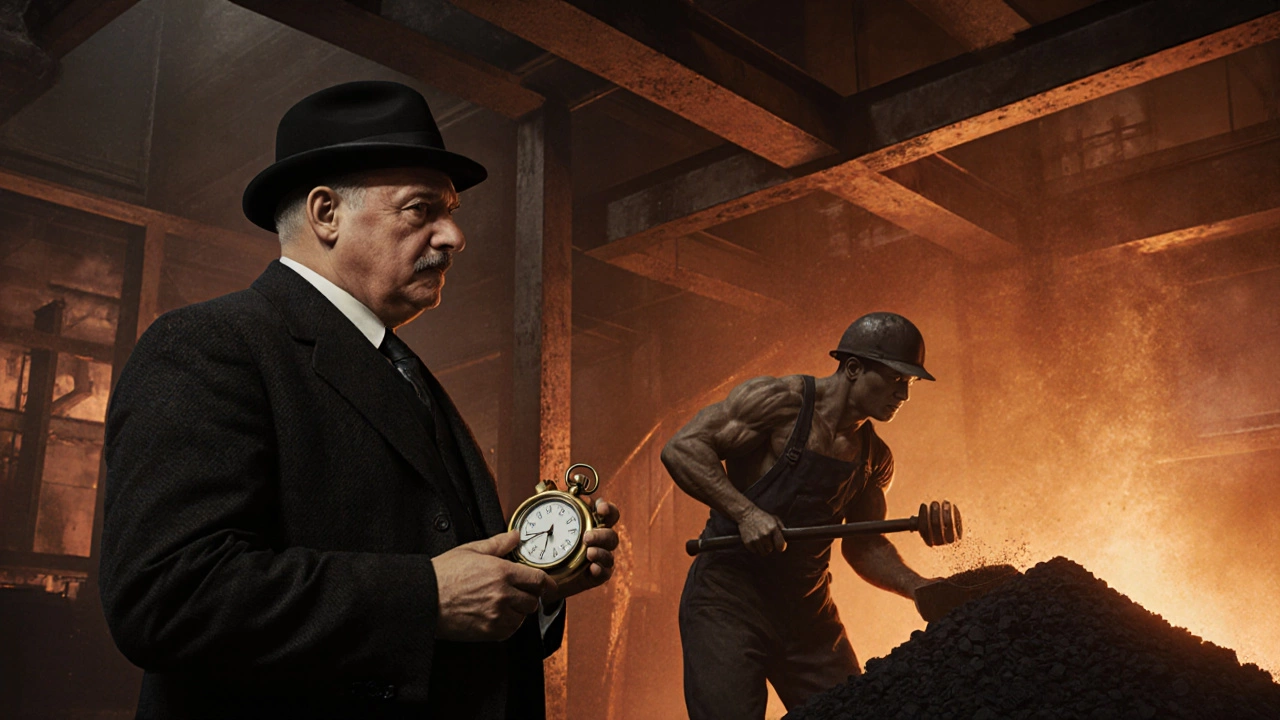Scientific Management Productivity Calculator
How This Tool Works
Enter your current productivity metrics to estimate potential gains from implementing scientific management principles. Based on real-world examples from the article, including Amazon fulfillment centers and Bethlehem Steel.
Tip: Typical productivity gains from scientific management implementation range from 20-30% based on historical case studies. Enter your current metrics to see what impact this could have on your operations.
Key Takeaways
- Scientific management uses data, observation, and standardization to boost productivity.
- Frederick Taylor’s time‑and‑motion studies laid the groundwork for modern workflow design.
- Amazon fulfillment centers illustrate a 21st‑century application of scientific management principles.
- Implementing scientific management starts with a clear task analysis, standardized work steps, and performance‑based pay.
- Avoid common pitfalls by involving workers in design and regularly reviewing metrics.
What Is Scientific Management?
When people ask for a scientific management example, they’re looking for a real‑world case where a business turns raw labor into a measured, repeatable process. In plain terms, scientific management is a way of studying work the way a scientist studies an experiment: observe, record, analyze, and then set a standard.
Scientific Management is a management theory developed in the early 1900s that applies scientific methods to the design of work tasks, aiming to increase efficiency and reduce waste. The core idea is simple-if you can break a job down into its smallest steps and measure each step, you can discover the fastest, safest, and cheapest way to do it.
Who Created It? Frederick Taylor and His Legacy
Frederick Winslow Taylor is the American engineer often called the ‘father of scientific management’, best known for pioneering time‑and‑motion studies and the concept of the ‘one best way’ to perform a task. In the early 1900s, Taylor watched workers at a steel plant, timed each motion, and then rearranged the workflow so the average output rose by 30% while injuries fell.
His approach sparked a wave of change across factories, railroads, and even office settings. While some early adopters treated his ideas as a rigid rulebook, today they serve as the backbone of many modern lean and Six Sigma programs.

The Building Blocks: Core Principles and Tools
Scientific management rests on three practical tools that you’ll see in almost any example:
- Time and Motion Study is a systematic observation technique that records the duration of each movement a worker makes, allowing analysts to identify and eliminate unnecessary steps.
- Standardized Work is a documented set of procedures that defines the exact sequence, timing, and tools required for a task, ensuring every worker follows the same best practice.
- Piece‑Rate Pay is a compensation model that ties wages directly to the amount of work completed, motivating employees to meet or exceed the set standard.
When you combine these tools, you get a repeatable system that can be measured, tweaked, and scaled.
Classic Case Study: The Bethlehem Steel Plant
One of the first vivid illustrations of scientific management came from Bethlehem Steel in 1910. Taylor’s team timed a worker shoveling coal and found that the average rate was 15 shovels per minute. By redesigning the shovel handle, adjusting the worker’s stance, and assigning each worker a specific zone, they boosted output to 23 shovels per minute-a 53% jump.
The plant also introduced a piece‑rate system: workers earned a bonus for each shovel beyond the 15‑shovel baseline. Within months, productivity rose and labor disputes fell, because workers could see the direct link between effort and pay.
Although the steel industry has evolved, the lesson remains: measure the task, set a clear standard, and reward performance.
Modern Example: Amazon Fulfillment Centers
Fast forward to 2025, and the most recognizable example of scientific management lives in the aisles of Amazon’s fulfillment centers. While the company calls its system “operational excellence”, the mechanics echo Taylor’s century‑old ideas.
Amazon Fulfillment Center is a large‑scale warehouse where thousands of items are stored, picked, packed, and shipped using a blend of automation, standardized work, and performance‑based incentives. Here’s how the three core tools appear in practice:
- Time‑and‑motion data collection: Handheld scanners and ceiling‑mounted cameras capture every second a worker spends walking, scanning, or packing. The data feeds an AI dashboard that flags bottlenecks.
- Standardized work stations: Each picking station is laid out with the exact same shelf heights, bin sizes, and tool placements. New hires watch a 5‑minute video that shows the “one best way” to retrieve an item.
- Performance‑based pay: Workers receive bonuses for hitting a “pick‑rate” that exceeds the center’s average by a set percentage. The bonus is transparent; if the average is 150 picks per hour, a worker earning 165 picks gets a $2 extra per hour.
The result? Amazon reports a 20‑30% increase in items processed per square foot compared to legacy warehouses, while average order‑to‑delivery time shrinks to under 48hours.
Critics argue that the pressure can feel relentless, but Amazon counters with “safety circles” where teams discuss ergonomic adjustments and stress‑relief breaks-an evolution of the early criticism of scientific management’s dehumanizing side.

Quick Checklist: Deploying Scientific Management in Your Workplace
| Step | What to Do | Key Metric |
|---|---|---|
| 1 | Pick a repeatable task and map every motion | Cycle time (seconds) |
| 2 | Identify non‑value‑adding steps and eliminate them | Reduced motion count |
| 3 | Create a written standard operating procedure (SOP) | Compliance rate (%) |
| 4 | Introduce a piece‑rate or bonus tied to the new standard | Productivity gain (%) |
| 5 | Monitor performance with real‑time dashboards and adjust as needed | Variance from target |
Use this table as a road map. Start small-perhaps with a packaging line or a data‑entry routine-then scale the approach once you see measurable gains.
Common Pitfalls & How to Avoid Them
- Ignoring worker input: When employees feel the system is imposed from above, resistance grows. Hold a short “design huddle” after the first observation round to capture their insights.
- Over‑standardizing: Not every task benefits from a rigid SOP. Keep flexibility for creative problem‑solving in roles that require judgement.
- Focusing only on speed: Safety and quality can suffer if speed is the sole metric. Include defect rates and ergonomic scores in your dashboard.
- Setting unrealistic piece‑rate targets: If the bonus is too ambitious, morale dips. Base rates on historical best‑in‑class data, then gradually raise them.
When Scientific Management Works Best
Think of tasks that are repetitive, measurable, and have a clear output-like assembling a component, processing orders, or handling customer calls. In high‑volume environments, the payoff can be dramatic. In contrast, roles that rely heavily on creativity or deep expertise (e.g., R&D, strategic planning) usually benefit more from agile or knowledge‑worker frameworks.
Frequently Asked Questions
What distinguishes scientific management from lean manufacturing?
Both aim to cut waste, but scientific management leans heavily on time‑and‑motion studies and piece‑rate pay, whereas lean focuses on value‑stream mapping, continuous improvement (kaizen), and respect for people. In practice, lean often adopts scientific tools like standardized work while adding a stronger cultural layer.
Can scientific management be applied to knowledge‑work?
Yes, but you must adapt the metrics. Instead of counting physical motions, track steps in a workflow-e.g., number of tickets resolved per hour, average handling time, or code review cycle. The principle of measuring and standardizing still holds.
Is piece‑rate pay illegal in today’s labor laws?
No, piece‑rate compensation is legal in most countries as long as the total earnings meet minimum wage requirements and overtime rules are followed. Employers must clearly disclose rates and ensure workers can earn a fair wage.
How does technology enhance scientific management today?
Sensors, wearables, and AI analytics capture real‑time motion data, allowing managers to update standards instantly. Cloud dashboards let frontline workers see their performance versus the benchmark, fostering transparency.
What’s a quick way to start a time‑and‑motion study?
Grab a stopwatch, choose a single repeatable task, and record the start‑and‑stop times for each sub‑step over five cycles. Average the times, identify the longest step, and brainstorm ways to shorten it.




